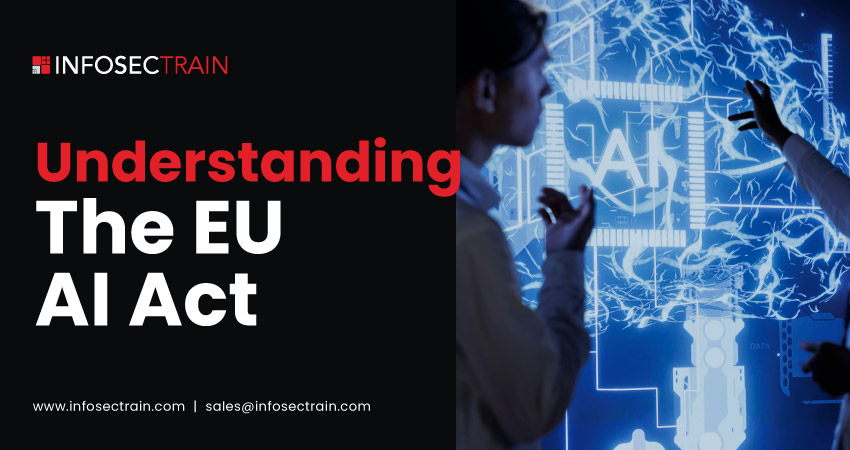Understanding The EU AI Act
The EU AI Act is the first legislative Artificial Intelligence (AI) regulation presented by the European Union (EU) to regulate AI across its member nations. It is part of the EU’s broader plan to foster trustworthy AI technology while promoting innovation and competitiveness in the digital economy.

What is the EU AI Act?
The EU AI Act is a proposed regulation that establishes guidelines for the secure and ethical use of AI in the EU. The purpose of this initiative is to ensure the security of AI systems and protect all fundamental rights. The Act categorizes AI systems based on risk, from unacceptable to minimal, ensures transparency and accountability, and maintains safety while encouraging innovation through transparent regulatory frameworks and compliance standards.
Key Purposes of the EU AI Act
- Protect Fundamental Rights: Focused on safeguarding fundamental rights, ensuring AI does not discriminate or invade privacy, or otherwise harm individuals.
For example, AI systems used in hiring should not be biased against candidates based on gender or age.
Enhance Security: Aim to ensure AI systems are safe and reliable, performing as intended without causing harm.
For example, AI systems used in manufacturing robots must operate within strict safety parameters to prevent accidents. - Transparency in AI Interactions: Encourages transparency in AI systems, making it clear when individuals are interacting with AI.
For example, when someone is chatting with a virtual customer service agent or a chatbot, the AI must disclose that it is not a human. - Promote Accountability: Mandates that the AI’s decisions be explainable, allowing users to understand and hold the system accountable for its outcomes.
For example, if an AI algorithm is used to approve or deny loan applications, the system must be able to explain the reasoning behind each decision to both the applicant and the bank. - Support Innovation: Support innovation by creating a clear regulatory environment that encourages the development of AI technologies aligned with ethical and social standards. For example, a government could offer grants and tax incentives for companies developing AI solutions that address social challenges, like improving access to healthcare or education.
How Does the EU AI Act Work?
The Act uses a risk-based approach, categorizing AI systems into four levels of risks based on their potential impact on people:
- Unacceptable Risk: AI systems are considered a clear threat to people’s safety, livelihoods, and rights, and they will be banned. Examples include AI systems designed to manipulate human behavior, exploit vulnerabilities of specific groups, or be used by governments for social scoring.
- High Risk: AI systems that significantly impact people’s safety or fundamental rights, such as those used in healthcare, law enforcement, critical infrastructure (like transport), or essential private and public services, are subject to strict regulations.
- Limited Risk: AI systems have limited risks but are not considered harmful enough for strict regulation. They are subject to specific transparency rules, such as notifying users when interacting with AI systems like chatbots or virtual assistants.
- Minimal Risk: Most AI systems are classified in this category and are mainly unregulated, as they pose little or no risk to people’s rights and safety. Examples include AI used for spam filtering in emails, which operates with minimal risk and does not require strict oversight.
What are the Rules for High-Risk AI Systems?
For AI systems classified as high-risk, the EU AI Act imposes several important rules:
- High-Quality Data: To minimize biases and ensure fairness, AI systems must use high-quality data, such as accurate and representative datasets that reflect diverse populations and scenarios relevant to the system’s application.
- Clear Documentation: Developers maintain comprehensive documentation that clearly explains the AI system’s workings and enables it to be quickly assessed for compliance.
- Transparency: Users must be informed when interacting with an AI system and given proper guidance and instructions.
Human Oversight: Mechanisms for human oversight must be included to prevent potential damage and maintain accountability for the system’s activities and decisions. - Robustness and Security: The AI systems must be designed to be reliable and secure against attacks or misuse.
IAPP AIGP Certification Training with InfosecTrain
With expert instructors, you will understand more about the EU AI Act at InfosecTrain‘s IAPP AIGP Certification Training course. This course covers the fundamental concepts of artificial intelligence, its applications, and its impact on society. Our course helps candidates to know about AI principles, how to address core risks and provide ethical guidance for trustworthy AI systems.
TRAINING CALENDAR of Upcoming Batches For
| Start Date | End Date | Start - End Time | Batch Type | Training Mode | Batch Status | |
|---|---|---|---|---|---|---|
| 10-May-2025 | 25-May-2025 | 19:00 - 23:00 IST | Weekend | Online | [ Open ] |







 1800-843-7890 (India)
1800-843-7890 (India)